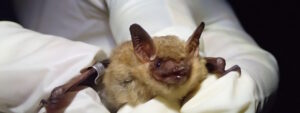Tri-colored Bat

Scientific Name: Perimyotis (Pipistrellus) subflavus
Description.
Tri-colored bats (formerly known as eastern pipistrelles) are small bats with yellowish-brown pelage. The dorsal pelage shows three distinct bands of color on each hair. The base is dark, a wide tan band extends along the majority of the hairs, and the ends are tipped in bronze. Their mass ranges from about 4.5 to 8 grams, and the wingspan ranges from about 210 to 260 mm, with the females being larger than the males.
Distribution.
Tri-colored bats are found throughout the eastern United States. And, their range extends north and east into Nova Scotia and Quebec, and southwest to eastern edge of Mexico and northern Honduras.
Ecology and Behavior.
Tri-colored bats are obligate hibernators, and are often found in places where the temperature stays constant, such as caves, rock crevices, and mines. They are often the first to hibernate each fall and the last to emerge in the spring due to their intolerance to freezing temperatures. These bats are often found hibernating individually, but groups of 2-3 have been observed. They are rarely found in buildings, as they prefer to roost in trees near areas of mixed agricultural use during the summer. The Tri-colored bat may be mistaken for a large moth due to its sporadic flying with a short elliptical flight pattern.
Food and Feeding.
Tri-colored bats often forage over waterways and forest edges, feeding on moths, beetles, midges, bugs, ants, mosquitoes, and other insects.
Reproduction and Development.
Mating occurs in the fall, and the females store the sperm until the spring. Tri-colored bats usually bear twins, and the females often form maternity colonies with an average of 15 individuals. The males roost individually and do not care for the young at all. Within a week the young are covered in fur, and by three weeks are able to fly. By the time the young are five weeks old, they are independent of their mothers.
Status.
Once one of the most common bats over most of its range. However, this species has been severely impacted by the devastating White-nose Syndrome caused by the fungus Pseudogymnoascus destructans.
- Click here to see where you can find the Tri-colored Bat in NC!
